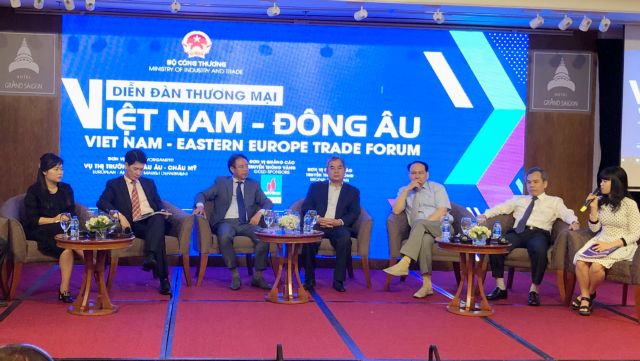Eastern European markets offer great potential to exporters given their relatively high GDP growth and less stringent quality requirements compared to Western European countries.

Eastern European markets offer great potential to exporters given their relatively high GDP growth and less stringent quality requirements compared to Western European countries.
But to succeed in exporting to these countries, Vietnamese firms must have long-term strategies, improve product quality and study the market carefully to make suitable products, the Viet Nam-Eastern Europe Trade Forum heard in HCM City on May 8.
Deputy Minister of Industry and Trade Hoang Quoc Vuong said Eastern Europe is Viet Nam’s traditional and important market.
The two sides have created solid legal frameworks for bilateral co-operation, including 14 intergovernmental committees, the Viet Nam-Poland economic co-operation consultation mechanism and the free trade agreement between Viet Nam and the Eurasian Economic Union (EAEU).
“The Viet Nam-EAEU FTA, which came into force in 2016, has brought economic benefits to all parties, with two-way trade reaching nearly US$5 billion last year, a year-on-year increase of 26 per cent.”
The proposed EU-Viet Nam FTA would further boost trade between Viet Nam and Eastern European countries, especially key Vietnamese exports such as seafood and vegetables, fresh and processed fruits, electronics and electronic components, textiles and footwear, he said.
But trade between Viet Nam and Eastern Europe countries was worth only $10.1 billion last year, very low compared to the potential of the two sides.
Nguyen Khanh Ngoc, deputy head of the European and American Market Department, said, “Viet Nam's exports to and imports from Eastern Europe account for nearly 3 per cent of its exports and 1.5 per cent of its imports.”
But the export of key products to these markets has not been stable, she said.
She urged exporters, especially of rice, seafood and tea, to focus on improving their product quality and carrying out promotions to penetrate these markets.
Russian market
Dmitry Makarov, head of the HCM City office of the Trade Representation of the Russian Federation in Viet Nam, said trade between Viet Nam and Russia topped $6 billion last year, up 16.4 per cent from 2017 and 58 per cent from 2016.
While Russian exports to Viet Nam are growing faster every year, in Viet Nam’s case it is slowing down, he said.
A change in Russian consumption habits and the less competitive prices of Vietnamese seafood are among the reasons for the latter, he said.
There are many famous Vietnamese garment and footwear brands with good quality and competitive prices, but they are not known in Russia, he said.
Russian businesses want to move their garment and textile factories from China to Viet Nam and others are subcontracting Vietnamese clothing and leather shoe companies, he said, adding this is a good opportunity to increase Vietnamese garment exports to Russia.
Challenges
Representatives of business groups and exporting firms at the forum said the potential notwithstanding they have difficulties in exporting to Eastern Europe, including payment issues, inconsistent regulations in these countries, small size of orders, and lack of market information.
Phan Thi Thanh Xuan, vice chairwoman of the Viet Nam Leather, Footwear and Handbags Association, said: “In the past Eastern Europe was Vietnamese leather and footwear industries’ key export market. But Vietnamese exporters have shifted to focus on the US and EU. Therefore, when they return to these markets, they face difficulties in payment methods and business culture.
“We have sent many business delegations to explore the markets, but businesses are afraid to change a culture they have established for decades with the US and EU.
“Businesses often introduce what they have not what the market needs.
“These are the biggest obstacles to accessing the markets.”
Business executives said authorities should regularly organise meetings to provide them with the latest market information.
Tran Dang Chung, chairman of Milton Company in Russia and former president of the Vietnamese Business Association in Russia, said Eastern European markets offer both challenges and opportunities for Vietnamese firms, which require them to have appropriate market strategies. — VNS





